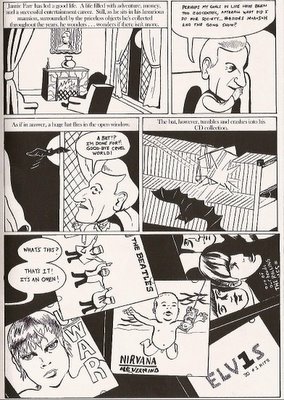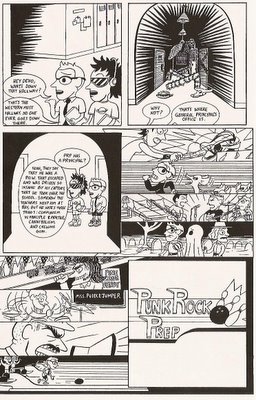
If mini-comics were shoved together haphazardly on the racks at your local comic shop, Jeff Zwirek’s would catch your attention. Black Star issue two has a stiff black cover with a cutout of a star in the middle. The star shows up white because of the front page, but there’s a silver pin with a black star inside the cut out. It’s a clean, multi-layered design that immediately stands out. Issue three has a white cover with a black star just above center. Underneath the black star, there’s the BLACKSTAR logo created with a retro label maker stuck to the cover.
Inside each issue of Black Star, there’s three to six short pieces, including stories of a super group comprising Bono, Mick Jagger, the angel of Elvis, a zombie Kurt Cobain, and the Jedi ghost of John Lennon. Like that’s not worth the two buck cover price alone: Jamie Farr sits in his lonely mansion pondering a life lived when a huge bat crashes through the window providing him directions to his most pressing questions. The bat crashes into his CD collection, knocking down copies of CDs by – you guessed it – U2, The Beatles, Nirvana, Elvis, and The Rolling Stones.

Issues two and three both start out with continuing mini-comic themed stories and they’re both engaging. “Comix, Anarchy, Riot,” from issue two, begins the urban myth exploration of an elusive talented mini-comic artist. Here Zwirek, as he’s tracking the mini-comic artist that exists just beyond his reach, lures you in with internal quotes like “I began reading comics at the height of the superhero boom of the early nineties. Lured and dazzled by their stylish dynamics and gimmick covers. But sometimes stupid wears off.” He continues by berating fanboys who see Ware as simplistic next to McFarlane.
The rest of issue two is the charming “Super Group” and the less charming “Jesus-5”; Five Jesus children each with their own super power. This wasn’t horrible, it just seemed like a lengthy supernatural superhero story, which felt oddly out of place after reading “Comix, Anarchy, Riot.” And then, just when you might start to feel a little indifferent, Zwirek hits you with “Saddle Shoes.” This story escapes the traditional panel after panel structure and strikes out on its own with nary a panel border in sight. Images flow into each other naturally as a man chases a woman through the physical and chronological dimension. The passage of time starts slowly on the third page: “It wasn’t long before we were on the ocean. I pass through my twenties. Porpoise spray lights up the sky like glass. And she still runs…I’m fifty, I’m twelve.” This is a moving section of the book, especially for anyone caught up in the love of a lifetime. “Saddle Shoes” is one of those rare stories that show pull back the veil and show the reader something meaningful and deep.
Issue two ends with a short interview with Jeffrey Brown. There’s certainly nothing wrong with that.
Issue three picks up where “Comix, Anarchy, Riot” ended. “How to Fail in Mini-Comics” has the elusive mini-comics artist/satyr character lead the real life Jeff Zwirek into a small press convention. Here, Zwirek compartmentalizes the different small press fans into more or less realistic groups of players, including my favorite: “The promotionalist is the transient type, but his endgame is big league comics. He thinks that a small press start up will grow and turn into the next Marvel or DC. He’s stupid enough to plunk a bunch of dough into a print run on some bullshit superhero retread.” This story ends with the Zwirek’s guide loudly announcing that Zwirek not only “voted for Dubya,” but that he is currently reading Atlas Shrugged. Ouch.
The rest of issue three consists of a story where “Watergate era Nixon gathers several dead presidents to run a series of bank heists,” and a visually interesting story called “Punk Rock Prep School.” The “Prep School” finishes with a more daring panel structure than the panel-less “Saddle Shoes.” I’ve scanned the page for you below, but notice how the last three panels don’t really follow the story; they’re segmented into four thin strips that provide an intense image that relates to the story in a less direct way. A guitar smashes against a table, toothy “racing bred Chihuahuas” chase a student, a fledgling punk band performs at full throttle, and three costumes figures transverse a graveyard – that’s one panel. Zwirek has a pretty good handle on the art in both of these books, but these last three panels of the third issue are the most exciting.

Check out Zwirek’s comics at his website. Both issues of Black Star are only two dollars each. Issue two is 52 pages and issue three is 24 pages. There are also short previews at his site from these two minis, as well as his Jack Rabbit series.





No comments:
Post a Comment